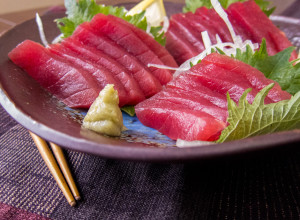Sushi and wine are the gastronomic ambassadors of their respective cultures, and as such, their mariage is at the heart of Japanese food and wine pairings. But with such a variety of sushi styles and ingredients, finding a single perfect wine can prove difficult, if not impossible.
Some might argue that Champagne (esp. a Blanc de Noirs) comes pretty close, and a nice rosé will definitely accompany a mixed sushi platter with great success. In fact, as long as you stay clear of oak and tannins, a disastrous mismatch is quite unlikely. To create a gustatory experience worth remembering however, one has to break it down and reduce the number of sushi types served.
To see precision pairings for individual sushi ingredients, check out the Japanese food and wine pairing chart.
Sashimi
 While sushi comes in many shapes and sizes, sashimi embodies the simplicity and purity of ingredients which has made Japanese cuisine so popular.
While sushi comes in many shapes and sizes, sashimi embodies the simplicity and purity of ingredients which has made Japanese cuisine so popular.
Because sashimi does not include rice, we generally prefer dry wines whose aromas will not interfere too much with the delicate flavors. Whether we then choose a lighter or fuller white, or even a red, depends on the particular sashimi’s texture.
Sushi
 Sushi on the other hand, in all of its forms, does include rice. In fact, the word sushi is phonetically derived from the “su” (vinegar) and “meshi” (rice), but sugar is also included in the preparation.
Sushi on the other hand, in all of its forms, does include rice. In fact, the word sushi is phonetically derived from the “su” (vinegar) and “meshi” (rice), but sugar is also included in the preparation.
Just how sweet the sushi rice will be depends on the house style, but in any case, it does add another flavor component to the popular nigiri (single topping on sushi rice) or maki (sushi roll) which can slightly affect the wine pairing. A good practice is to choose a slightly fruitier version of the recommended wines, and in some cases, a touch of residual sugar can even be most welcome.
A sweeter wine becomes almost necessary when considering inari-zushi (sushi rice wrapped inside sweet tofu pockets), as well as the kansai gomoku-zushi (sweetened vegetables mixed into a bowl of sushi rice), while the traditional chirashi-zushi (mixed sashimi served over a bowl of sushi rice) goes well with the more versatile Champagne or rosé mentioned earlier.
Soy Sauce & Wasabi
I’ve come across articles which focus their sushi and wine pairings on soy sauce and wasabi, but I don’t really agree with this approach. While many westerners indeed drown their sushi in a potent soy/wasabi mixture (so did I before first going to Japan), sushi should taste like sushi, and excessive soy sauce should be avoided.
To best appreciate the fresh ingredients, dip only a tiny corner of the fish or other topping (never the rice!) for no more than a second. The role of the soy sauce is to enhance the flavors, not cover them.
This is also true of wasabi, and in Japan, it is usually already included in the maki, or between the rice and the topping of a nigiri. While some people mix a small amount of wasabi into their soy sauce when eating sashimi, others prefer to rub a tiny bit of the spicy green paste on the sashimi before dipping (again, very lightly).
This actually makes the wasabi taste slightly spicier, but not so much that it interferes with the delicate sushi flavors. Instead, the mustard-like spice enhances the aromas of the sashimi, and this is ultimately the desired effect, whether it be with soy sauce, wasabi or wine!
Wine vs. Sake
Finally, I’d like to discuss sake, the traditional Japanese sushi pairing. While I’ve often read claims that sake does not pair well with sushi rice, I actually disagree. The reasoning behind these statements is that the rice-derived aromas of sake intensify this facet of sushi, to the detriment of the neta (main ingredient, or topping). While I admit that delicate sashimi tends to pair better with Japanese sake because of its inherent purity, the truth is that quality sake of ginjou or daiginjou quality does not have rice-like aromas, but present fruitier notes of melon or persimmon instead.

Sake’s relatively neutral texture will pair well with all sushi, but with wine, it is important to choose one’s bottle carefully. For instance, I find that overly acidic, light whites will bring out a fishy taste in certain sushi (particularly salmon), but this never happens with the low-acid sake. When a wine pairing works out right however, it provides an experience that is just as good, if not better!





